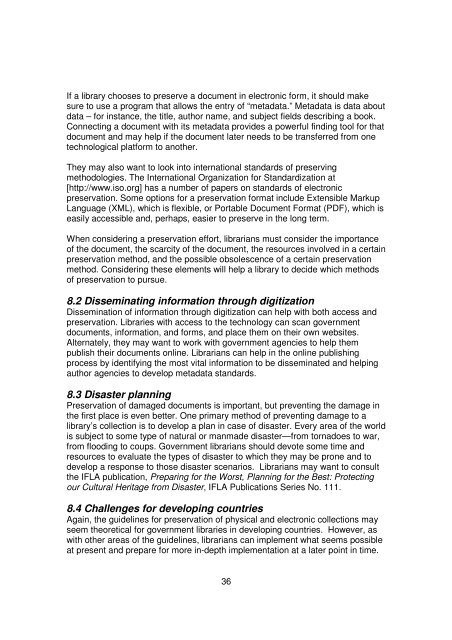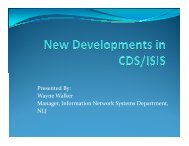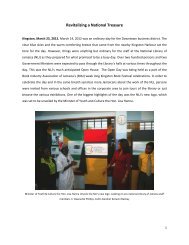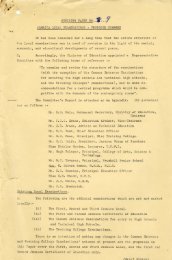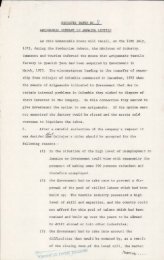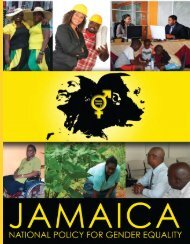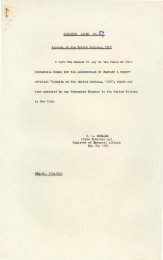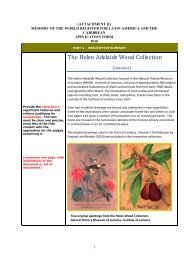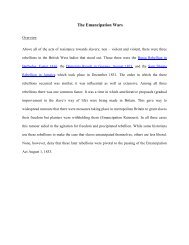Guidelines for Libraries of Government Departments - IFLA
Guidelines for Libraries of Government Departments - IFLA
Guidelines for Libraries of Government Departments - IFLA
You also want an ePaper? Increase the reach of your titles
YUMPU automatically turns print PDFs into web optimized ePapers that Google loves.
If a library chooses to preserve a document in electronic <strong>for</strong>m, it should make<br />
sure to use a program that allows the entry <strong>of</strong> “metadata.” Metadata is data about<br />
data – <strong>for</strong> instance, the title, author name, and subject fields describing a book.<br />
Connecting a document with its metadata provides a powerful finding tool <strong>for</strong> that<br />
document and may help if the document later needs to be transferred from one<br />
technological plat<strong>for</strong>m to another.<br />
They may also want to look into international standards <strong>of</strong> preserving<br />
methodologies. The International Organization <strong>for</strong> Standardization at<br />
[http://www.iso.org] has a number <strong>of</strong> papers on standards <strong>of</strong> electronic<br />
preservation. Some options <strong>for</strong> a preservation <strong>for</strong>mat include Extensible Markup<br />
Language (XML), which is flexible, or Portable Document Format (PDF), which is<br />
easily accessible and, perhaps, easier to preserve in the long term.<br />
When considering a preservation ef<strong>for</strong>t, librarians must consider the importance<br />
<strong>of</strong> the document, the scarcity <strong>of</strong> the document, the resources involved in a certain<br />
preservation method, and the possible obsolescence <strong>of</strong> a certain preservation<br />
method. Considering these elements will help a library to decide which methods<br />
<strong>of</strong> preservation to pursue.<br />
8.2 Disseminating in<strong>for</strong>mation through digitization<br />
Dissemination <strong>of</strong> in<strong>for</strong>mation through digitization can help with both access and<br />
preservation. <strong>Libraries</strong> with access to the technology can scan government<br />
documents, in<strong>for</strong>mation, and <strong>for</strong>ms, and place them on their own websites.<br />
Alternately, they may want to work with government agencies to help them<br />
publish their documents online. Librarians can help in the online publishing<br />
process by identifying the most vital in<strong>for</strong>mation to be disseminated and helping<br />
author agencies to develop metadata standards.<br />
8.3 Disaster planning<br />
Preservation <strong>of</strong> damaged documents is important, but preventing the damage in<br />
the first place is even better. One primary method <strong>of</strong> preventing damage to a<br />
library’s collection is to develop a plan in case <strong>of</strong> disaster. Every area <strong>of</strong> the world<br />
is subject to some type <strong>of</strong> natural or manmade disaster—from tornadoes to war,<br />
from flooding to coups. <strong>Government</strong> librarians should devote some time and<br />
resources to evaluate the types <strong>of</strong> disaster to which they may be prone and to<br />
develop a response to those disaster scenarios. Librarians may want to consult<br />
the <strong>IFLA</strong> publication, Preparing <strong>for</strong> the Worst, Planning <strong>for</strong> the Best: Protecting<br />
our Cultural Heritage from Disaster, <strong>IFLA</strong> Publications Series No. 111.<br />
8.4 Challenges <strong>for</strong> developing countries<br />
Again, the guidelines <strong>for</strong> preservation <strong>of</strong> physical and electronic collections may<br />
seem theoretical <strong>for</strong> government libraries in developing countries. However, as<br />
with other areas <strong>of</strong> the guidelines, librarians can implement what seems possible<br />
at present and prepare <strong>for</strong> more in-depth implementation at a later point in time.<br />
36


